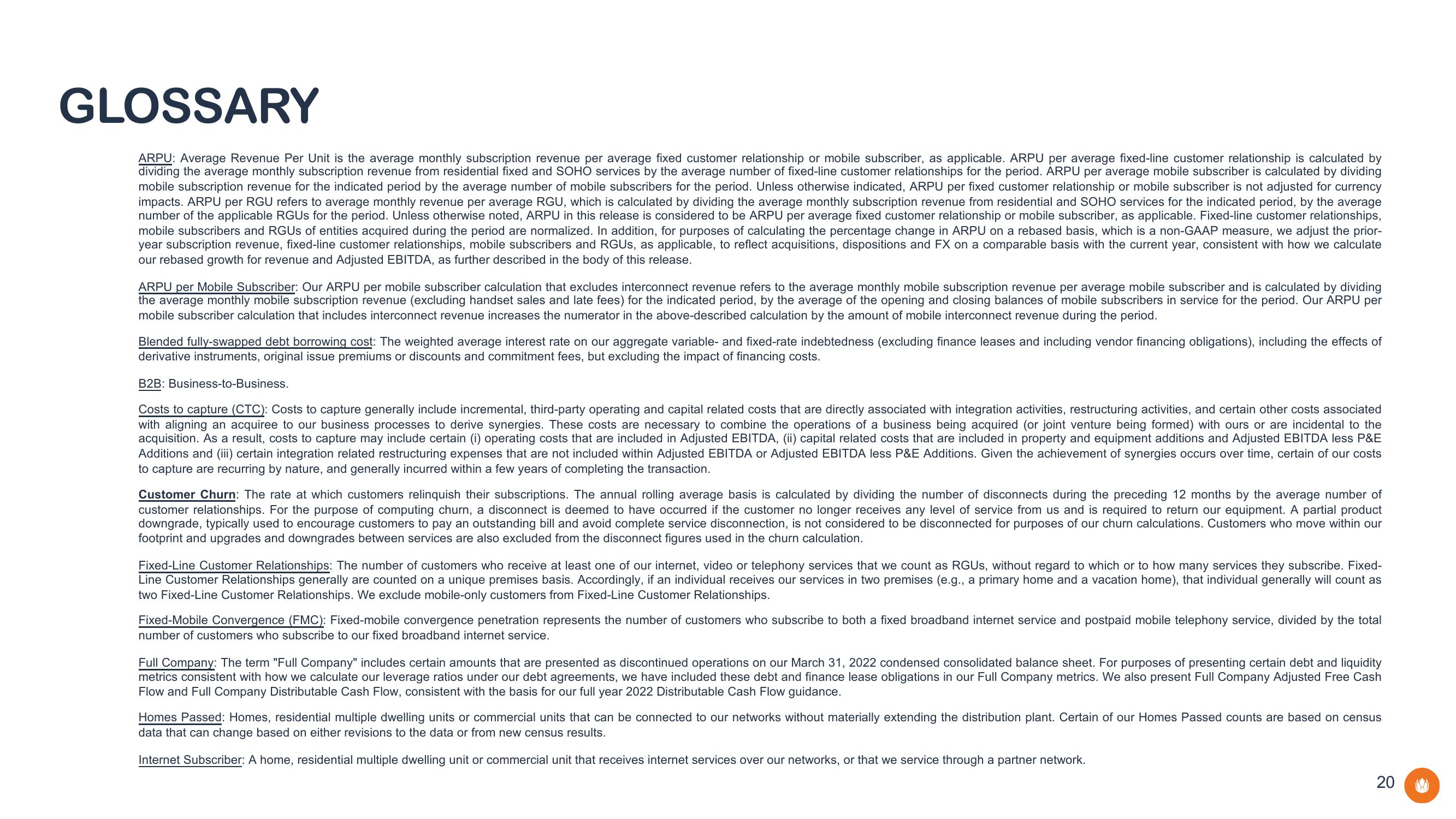Liberty Global Results Presentation Deck
GLOSSARY
ARPU: Average Revenue Per Unit is the average monthly subscription revenue per average fixed customer relationship or mobile subscriber, as applicable. ARPU per average fixed-line customer relationship is calculated by
dividing the average monthly subscription revenue from residential fixed and SOHO services by the average number of fixed-line customer relationships for the period. ARPU per average mobile subscriber is calculated by dividing
mobile subscription revenue for the indicated period by the average number of mobile subscribers for the period. Unless otherwise indicated, ARPU per fixed customer relationship or mobile subscriber is not adjusted for currency
impacts. ARPU per RGU refers to average monthly revenue per average RGU, which is calculated by dividing the average monthly subscription revenue from residential and SOHO services for the indicated period, by the average
number of the applicable RGUs for the period. Unless otherwise noted, ARPU in this release is considered to be ARPU per average fixed customer relationship or mobile subscriber, as applicable. Fixed-line customer relationships,
mobile subscribers and RGUS of entities acquired during the period are normalized. In addition, for purposes of calculating the percentage change in ARPU on a rebased basis, which is a non-GAAP measure, we adjust the prior-
year subscription revenue, fixed-line customer relationships, mobile subscribers and RGUS, as applicable, to reflect acquisitions, dispositions and FX on a comparable basis with the current year, consistent with how we calculate
our rebased growth for revenue and Adjusted EBITDA, as further described in the body of this release.
ARPU per Mobile Subscriber: Our ARPU per mobile subscriber calculation that excludes interconnect revenue refers to the average monthly mobile subscription revenue per average mobile subscriber and is calculated by dividing
the average monthly mobile subscription revenue (excluding handset sales and late fees) for the indicated period, by the average of the opening and closing balances of mobile subscribers in service for the period. Our ARPU per
mobile subscriber calculation that includes interconnect revenue increases the numerator in the above-described calculation by the amount of mobile interconnect revenue during the period.
Blended fully-swapped debt borrowing cost: The weighted average interest rate on our aggregate variable- and fixed-rate indebtedness (excluding finance leases and including vendor financing obligations), including the effects of
derivative instruments, original issue premiums or discounts and commitment fees, but excluding the impact of financing costs.
B2B: Business-to-Business.
Costs to capture (CTC): Costs to capture generally include incremental, third-party operating and capital related costs that are directly associated with integration activities, restructuring activities, and certain other costs associated
with aligning an acquiree to our business processes to derive synergies. These costs are necessary to combine the operations of a business being acquired (or joint venture being formed) with ours or are incidental to the
acquisition. As a result, costs to capture may include certain (i) operating costs that are included in Adjusted EBITDA, (ii) capital related costs that are included in property and equipment additions and Adjusted EBITDA less P&E
Additions and (iii) certain integration related restructuring expenses that are not included within Adjusted EBITDA or Adjusted EBITDA less P&E Additions. Given the achievement of synergies occurs over time, certain of our costs
to capture are recurring by nature, and generally incurred within a few years of completing the transaction.
Customer Churn: The rate at which customers relinquish their subscriptions. The annual rolling average basis is calculated by dividing the number of disconnects during the preceding 12 months by the average number of
customer relationships. For the purpose of computing churn, a disconnect is deemed to have occurred if the customer no longer receives any level of service from us and is required to return our equipment. A partial product
downgrade, typically used to encourage customers to pay an outstanding bill and avoid complete service disconnection, is not considered to be disconnected for purposes of our churn calculations. Customers who move within our
footprint and upgrades and downgrades between services are also excluded from the disconnect figures used in the churn calculation.
Fixed-Line Customer Relationships: The number of customers who receive at least one of our internet, video or telephony services that we count as RGUs, without regard to which or to how many services they subscribe. Fixed-
Line Customer Relationships generally are counted on a unique premises basis. Accordingly, if an individual receives our services in two premises (e.g., a primary home and a vacation home), that individual generally will count as
two Fixed-Line Customer Relationships. We exclude mobile-only customers from Fixed-Line Customer Relationships.
Fixed-Mobile Convergence (FMC): Fixed-mobile convergence penetration represents the number of customers who subscribe to both a fixed broadband internet service and postpaid mobile telephony service, divided by the total
number of customers who subscribe to our fixed broadband internet service.
Full Company: The term "Full Company" includes certain amounts that are presented as discontinued operations on our March 31, 2022 condensed consolidated balance sheet. For purposes of presenting certain debt and liquidity
metrics consistent with how we calculate our leverage ratios under our debt agreements, we have included these debt and finance lease obligations in our Full Company metrics. We also present Full Company Adjusted Free Cash
Flow and Full Company Distributable Cash Flow, consistent with the basis for our full year 2022 Distributable Cash Flow guidance.
Homes Passed: Homes, residential multiple dwelling units or commercial units that can be connected to our networks without materially extending the distribution plant. Certain of our Homes Passed counts are based on census
data that can change based on either revisions to the data or from new census results.
Internet Subscriber: home, residential multiple dwelling unit or commercial unit that receives internet services over our networks, or that we service through a partner network.
20View entire presentation